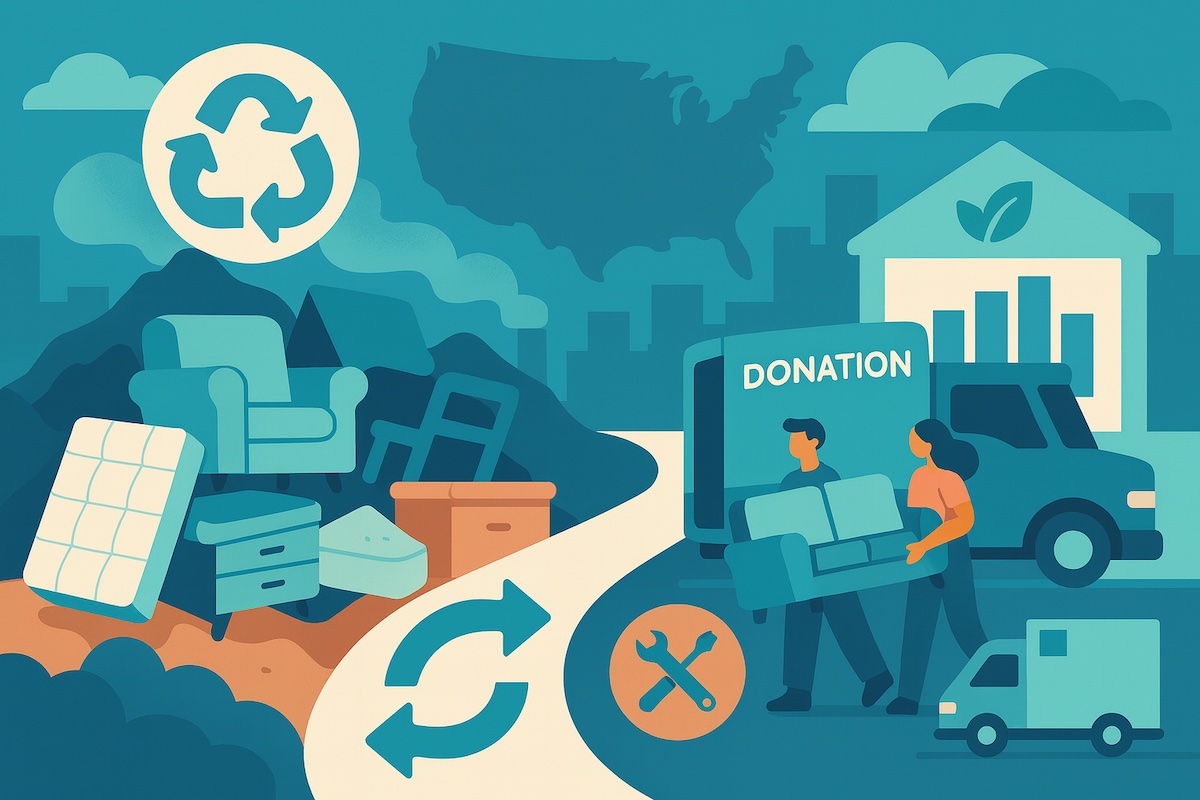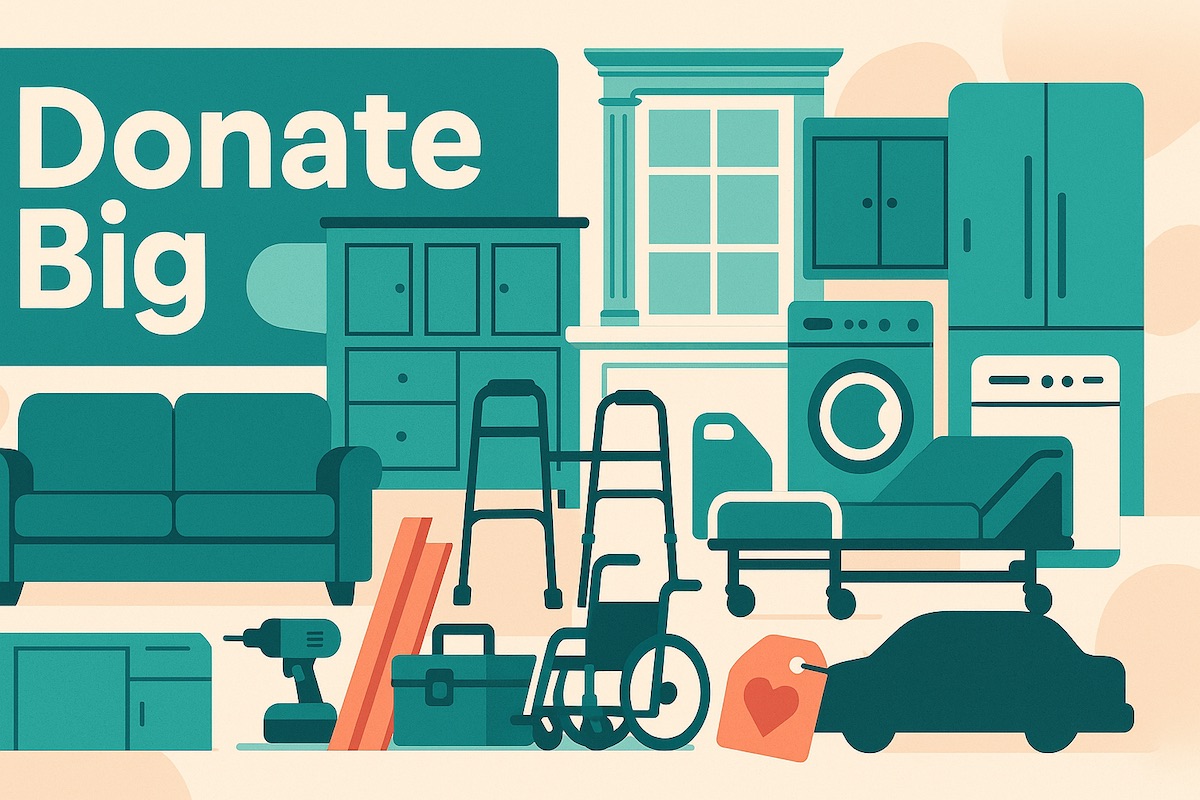Facing America’s Furniture Waste Problem

The couch by the curb isn’t just an eyesore, it’s a symptom of a system that makes big items easy to buy and too easy to toss. Here’s what the numbers look like, why furniture is so hard to recycle, and the smartest ways to keep pieces in use (and out of landfills).
The Scale: How Much Furniture Are We Trashing?
In the most recent comprehensive EPA tables, Americans generated about 12.1 million tons of furniture and furnishings in 2018—roughly 9.7 million tons went to landfills, or about 80% of the total.[1] [2] EPA’s durable-goods summary shows that bulky items remain one of the most landfilled product categories in municipal solid waste.[3]
Why Furniture Is So Hard to Recycle
Most modern pieces are a mash-up of composite wood (particleboard/MDF) plus foams, plastics, fabrics, metal fasteners, and adhesives. That cocktail is tough to separate cost-effectively, so recyclers rarely touch it.[4] [5]
- Composite wood woes: Particleboard and MDF can’t be sanded like solid wood and are difficult to recycle because of resins and binders.[4]
- Mixed materials: Stripping fabrics, foam, staples, and glues from frames is labor-intensive and rarely profitable at small scale.[5]
- Bulky logistics: Big, heavy items are expensive to haul and store, so many end up in the landfill stream by default.[3]
The “Fast Furniture” Effect
Cheaper, flat-pack pieces with short lifespans have exploded—great for quick style flips, not great for waste.
Reporting on the trend notes that low-cost, short-use furniture is clogging curb lanes and disposal sites as consumers churn through decor faster than ever.[6]
Why it’s growing
- Low prices, fast trends: When something is cheaper to replace than repair, it becomes disposable—and seasonal styles push faster turnover.
- Composite construction: Laminates, foams, and particleboard keep costs down but don’t age well under stress or moisture.
- Convenience culture: One-click delivery and easy returns encourage try-and-toss behavior that didn’t exist a decade ago.
What this looks like on the curb
- Peeling laminates & sagging frames: Once the substrate swells or the fasteners strip, repair isn’t worth the time for most households.
- “Starter” sets with short careers: Nightstands, TV stands, and desks assembled for a move or semester—then abandoned when the next move hits.
- Mixed-material headaches: Fabrics glued to foam on engineered wood means disassembly is labor-intensive, so items default to landfill.
How to push back (without blowing the budget)
- Buy for the “hard points”: Choose solid wood or metal for tables, bed frames, and dressers—the pieces that take daily stress.
- Swap the soft stuff: Refresh with slipcovers, hardware, and legs; keep the frame, change the vibe.
- Plan a second life: Favor items you could resell, donate, or repair later. If it can’t survive a move, it probably won’t survive a year.
Bright Spots: Mattress Recycling & Reuse Infrastructure
While whole-furniture recycling is tricky, mattress stewardship programs in California, Connecticut, and Rhode Island prove that targeted systems can work.
The Mattress Recycling Council reports millions of mattresses recycled through its “Bye Bye Mattress” network, diverting steel, foam, and fibers back into new products.[7] [8]
What You Can Do (That Actually Helps)
1) Extend lifespans
- Buy better, buy fewer: Favor solid wood or metal frames with replaceable parts.
- Repair > replace: A $10 hardware swap or leg repair can add years to a dresser or chair.
- Refinish smartly: If a piece may have old, flaking paint (pre-1978), avoid dry-sanding; follow EPA lead-safe guidance.[9]
2) Reuse before recycle
- Donate large items: Many Habitat for Humanity ReStores offer free pickup for furniture and other bulky goods (varies by location).[10]
- Check local Goodwill policies: Some locations accept furniture (availability and floor space vary—always call first).[11]
- Resell or gift: Keep items in use via neighborhood marketplaces and “free” groups.
3) Be mattress-smart
- Use stewardship programs: Residents in CA/CT/RI can recycle through state-authorized drop-offs and events.[8]
- Sanitation matters for reuse: Inspect secondhand upholstery for pests; EPA’s IPM guidance includes inspection and encasements as non-chemical tools.[12]
FAQ: Practical Questions People Ask
Bottom Line
Furniture waste is a design and systems problem—not just a decluttering problem. Until products are easier to repair and disassemble, the fastest wins are reuse and responsible disposal. Donate when you can, buy for longevity, and use specialty programs (like mattress stewardship) when they exist. Your choices keep bulky items in homes, not in landfills.
References
- U.S. EPA — 2018 Tables and Figures, Table 14 (Generation of products in MSW; “Furniture and Furnishings”). EPA data tables or direct PDF: 2018 Tables & Figures (PDF).
- U.S. EPA — 2018 Tables and Figures, Table 17 (Landfilling of products in MSW; “Furniture and Furnishings”). EPA data tables.
- U.S. EPA — Durable Goods: Product-Specific Data. epa.gov.
- Green America — The Billion-Dollar Furniture Waste Problem. greenamerica.org.
- Waste360 — Tackling a Multi-Million-Ton Furniture Waste Problem. waste360.com.
- Debra Kamin — “Fast furniture is cheap, stylish and clogging landfills.” Reprint/summary. straitstimes.com.
- Mattress Recycling Council — 10-Year Impact Report. sleepproducts.org.
- Mattress Recycling Council — Bye Bye Mattress (program & locator). byebyemattress.com.
- U.S. EPA — Lead Renovation, Repair and Painting (RRP). epa.gov.
- Habitat for Humanity — Donate goods to ReStore (many locations offer large-item pickup). habitat.org.
- Goodwill Northern New England — Acceptable Donations. goodwillnne.org.
- U.S. EPA — Controlling Bed Bugs Using Integrated Pest Management (IPM). epa.gov.

